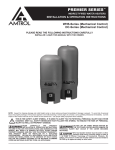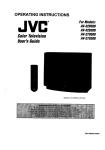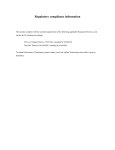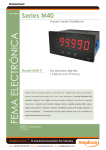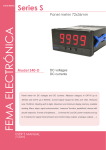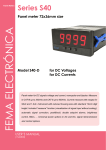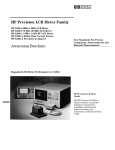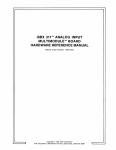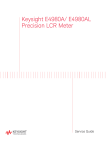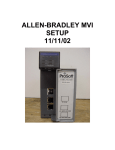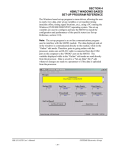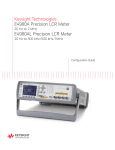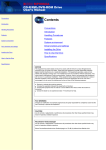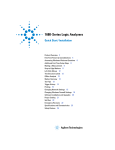Download Agilent 4284A Precision LCR Meter
Transcript
Test Equipment Depot 99 Washington Street Melrose, MA 02176-6024 Agilent 4284A www.testequipmentdepot.com 800-517-8431 781-665-0780 FAX Precision LCR Meter Data Sheet Specifications The complete Agilent Technologies 4284A specifications are listed in this data sheet. These specifications are the performance standards or limits against which the instrument is tested. When shipped from the factory, the Agilent 4284A meets the specifications listed here. Mathematical functions The deviation and the percent of deviation of measurement values from a programmable reference value. Equivalent measurement circuit Parallel and series Ranging Auto and manual (hold/up/down) Measurement Functions Measurement parameters |Z| = Absolute value of impedance |Y| = Absolute value of admittance L = Inductance C = Capacitance R = Resistance G = Conductance D = Dissipation factor Q = Quality factor Rs = Equivalent series resistance Rp = Parallel resistance X = Reactance B = Susceptance q = Phase angle Trigger Internal, external, BUS (GPIB), and manual Delay time Programmable delay from the trigger command to the start of the measurement, 0 to 60.000 s in 1 ms steps. Measurement terminals Four-Terminal pair Test cable length Standard 0 m and 1 m selectable With Option 4284A-006 0 m, 1 m, 2 m, and 4 m selectable Combinations of measurement parameters |Z|, |Y| L, C R G q (deg), q (rad) D, Q, Rs, Rp, G X B Integration time Short, medium, and long (see Supplemental Performance Characteristics for the measurement time) Averaging 1 to 256, programmable Frequency 20 Hz to 1 MHz, 8610 selectable frequencies Accuracies apply when test cable length is 0 m or 1 m. The additional error when test cable length is 2 m or 4 m is given as Accuracy ±0.01% fm x L [%] 2 Signal modes Normal – Program selected voltage or current at the measurement terminals when they are opened or shorted, respectively. where: Constant – Maintains selected voltage or current at the device under test (DUT) independent of changes in the device’s impedance. For example, Test Signal Signal level Voltage Current fm L = Test frequency [MHz] = Test cable length [m] DUT’s impedance: Test signal level: Measurement accuracy: 50 Ω 0.1 Vrms 0.1% Mode Range Setting accuracy Then, voltage level monitor accuracy is Non-constant 5 mVrms to 2 Vrms ±(10% + 1 mVrms) ±(3.1% of reading + 0.5 mVrms) Constant1 10 mVrms to 1 Vrms ±(6% + 1 mVrms) Non-constant 50 µArms to 20 mArms ±(10% + 10 µArms) Constant1 100 µArms to 10 mArms ±(6 % + 10 µArms) Display Range Parameter Range |Z|, R, X 0.01 Ω to 99.9999 MΩ |Y|, G, B 0.01 nS to 99.9999 S C 0.01 fF to 9.99999 F L 0.01 nH to 99.9999 kH D 0.000001 to 9.99999 Test signal level monitor Q 0.01 to 99999.9 Mode q –180.000° to 180.000° ∆ –999.999% to 999.999% 1. Automatic Level Control Function is set to ON. Output impedance 100 Ω, ±3% Voltage1 Current 2 Range Accuracy 5 mVrms to 2 Vrms ±(3% of reading + 0.5 mVrms) 0.01 Vrms to 5 mVrms ±(11% of reading + 0.1 mVrms) 50 µArms to 20 mArms ±(3% of reading + 0.5 µArms) 0.001 µArms to 50 µArms ±(11% of reading) + 1 µArms) 1. Add the impedance measurement accuracy [%] to the voltage level monitor accuracy when the DUT’s impedance is < 100 Ω. 2. Add the impedance measurement accuracy [%] to the current level monitor accuracy when the DUT’s impedance is ≥ 100 Ω. 2 Absolute Accuracy Absolute accuracy is given as the sum of the relative accuracy plus the calibration accuracy. q accuracy q accuracy is given as qe + qcal [deg] |Z|, |Y|, L, C, R, X, G, and B accuracy |Z|, |Y|, L, C, R, X, G, and B accuracy is given as where: Ae + Acal [%] qe = Relative q accuracy [deg] qcal = Calibration accuracy [deg] where: Ae = Relative accuracy Acal = Calibration accuracy G accuracy When Dx (measured D value) ≤ 0.1 G accuracy is given as L, C, X, and B accuracies apply when Dx (measured D value) ≤ 0.1. R and G accuracies apply when Qx (measured Q value) ≤ 0.1. G accuracy described in this paragraph applies to the G-B combination only. D accuracy D accuracy is given as De + qcal where: De is the relative D accuracy qcal is the calibration accuracy [radian] Accuracy applies when Dx (measured D value) ≤ 0.1. Q accuracy Q accuracy Qe is given as Qe = ± Q2x x Da – 1 + Qx x Da where: Bx Cx Lx Da f = = = = = G accuracy described in this paragraph applies to the Cp-G and Lp-G combinations only. Rp accuracy When Dx (measured D value) ≤ 0.1 Rp accuracy is given as Rp = ± where: Qx = Measured Q value Da = D accuracy Q accuracy applies when Qx x Da < 1. Measured B value [S] Measured C value [F] Measured L value [H] Absolute D accuracy Test frequency [Hz] Rpx x Da –D Dx + a [Ω] where: Rpx = Measured Rp value [Ω] Dx = Measured D value Da = Absolute D accuracy 3 Rs accuracy When Dx ( measured D value) ≤ 0.1 3. OPEN and SHORT corrections have been performed. Rs accuracy is given as 4. Bias current isolation: Off (For accuracy with bias current isolation, refer to supplemental performance characteristics.) 5. Test signal voltage and DC bias voltage are set according to Figure 1-2. where: Xx Cx Lx Da f = = = = = 6. The optimum measurement range is selected by matching the DUT’s impedance to the effective measuring range. (For example, if the DUT’s impedance is 50 kΩ, the optimum range is the 30 kΩ range.) Measured X value [Ω] Measured C value [F] Measured L value [H] Absolute D accuracy Test frequency [Hz] Range 1: Relative accuracy can apply. Relative Accuracy Relative accuracy includes stability, temperature coefficient, linearity, repeatability, and calibration interpolation error. Relative accuracy is specified when all of the following conditions are satisfied: Range 2: The limits applied for relative accuracy differ according to the DUT’s DC resistance. Three dotted lines show the upper limits when the DC resistance is 10 Ω, 100 Ω and 1 kΩ. 1. Warm-up time: ≥ 30 minutes 2. Test cable length: 0 m, 1 m, 2 m, or 4 m (Agilent 16048 A/B/D/E) DC resistance = 1 kΩ For 2 m or 4 m cable length operation, test signal voltage and test frequency are set according to Figure 1-1. (2 m and 4 m cable can only be used when Option 4284A-006 is installed.) Test signal voltage (Vrms) 20 DC resistance = 100 Ω DC resistance = 10 Ω 15 10 Range 1 Range 2 Range 3 5 0 2m cable 4m cable Test signal voltage (Vrms) 20 10 100 1k 10k 100k Frequency Hz 1M Figure 1-1. Test signal voltage and test frequency upper limits to apply relative accuracy to 2 m and 4 m cable length operation 4 5 10 15 20 25 30 35 40 DC bias voltage setting (V) Figure 1-2. Test signal voltage and DC bias voltage upper limits apply for relative accuracy 1 20 0 |Z|, |Y|, L, C, R, X, G, and B accuracy |Z|, |Y|, L, C, R, X, G, and B accuracy Ae is given as Q accuracy Q accuracy is given as Ae = ± [A + (Ka + Kaa + Kb x Kbb + Kc) x 100 + Kd] x Ke [%] ± A = Basic accuracy (refer to Figure 1-3 and 1-4) Ka = Impedance proportional factor (refer to Table 1-1) Kaa = Cable length factor (refer to Table 1-2) Kb = Impedance proportional factor (refer to Table 1-1) Kbb = Cable length factor (refer to Table 1-3) Kc = Calibration interpolation factor (refer to Table 1-4) Kd = Cable length factor (refer to Table 1-6) Ke = Temperature factor (refer to Figure 1-5) L, C, X, and B accuracies apply when Dx (measured D value) ≤ 0.1. R and G accuracies apply when Qx (measured Q value) ≤ 0.1. Q2x x De – 1 + Qx x De where: Qx = Measured Q value De = Relative D accuracy Accuracy applies when Qx x De < 1. q accuracy q accuracy is given as 180 x Ae [deg] π x 100 G accuracy When Dx (measured D value) ≤ 0.1 G accuracy is given as When Dx ≥ 0.1, multiply Ae by X, and B accuracies 1 + Dx2 for L, C, When Qx ≥ 0.1, multiply Ae by G accuracies. 1 + Qx2 for R and G accuracy described in this paragraph applies to the G-B combination only. D accuracy D accuracy De is given as De = ± Ae 100 Accuracy applies when Dx (measured D value) ≤ 0.1. where: Bx Cx Lx De f = = = = = Measured B value [S] Measured C value [F] Measured L value [H] Relative D accuracy Test frequency [Hz] G accuracy described in this paragraph applies to the Cp-G and Lp-G combinations only. When Dx > 0.1, multiply De by (1 + Dx). 5 Rp accuracy When Dx (measured D value) ≤ 0.1 Rp accuracy is given as ± Rpx x De – De [Ω] Dx + Example of C-D Accuracy Calculation Measurement conditions Frequency: 1 kHz C measured: 100 nF Test signal voltage: 1 Vrms Integration time: MEDIUM Cable length: 0m where: Then: Rpx = Measured Rp value [Ω] Dx = Measured D value De = Relative D accuracy A = 0.05 Rs accuracy When Dx (measured D value) ≤ 0.1 Rs accuracy is given as where: Xx Cx Lx De f = = = = = Measured X value [Ω] Measured C value [F] Measured L value [H] Relative D accuracy Test frequency [Hz] Therefore, Caccuracy = ±[0.05 + (7.5 x 10-7 + 1.70 x 10-6) x 100] ≈ ±0.05 [%] Daccuracy = ± 0.05 100 = ±0.0005 6 10 nF H 0.1 (0.2) A2 m 10 1µ F 10 0.05 (0.1) A1 µF 1k 10 10 H 1µ F 10 1 H 1m mF 0n 15 10 10 100m F 1 0.1 (0.2) A2 10 100m 100 10m Figure 1-3. Basic accuracy A (1 of 2) 0m F 10 10 nH 100 µH 0µ 10m H 0.1 (0.15) A2 1m F H 32k 10k 0n 0µ 100µ |Z| R.X 100k 10 10 320k H 1M 10µ H 1H 0.25 (0.3) A3 10 fP 0H 10 10 P H 0f 1k kH 10 0m F 10 |Y| G.B F 10M 1µ 1m 1p F 1n 100n pF 10 0p 100M 10n 10 10 0k [Ω] 10 [S] H Specification Charts and Tables 0.25 (0.3) A3 20 30 100 1k 10k 100k 1M [Hz] 30k 300k Testfrequency Frequency Test On boundary line apply the better value. Example of how to find the A value: 0.05 = A value when 0.3 Vrms ≤ Vs ≤ 1 Vrms and integration time is MEDIUM and LONG. (0.1) = A value when 0.3 Vrms ≤ Vs ≤ 1 Vrms and integration time is SHORT. A1 = A value when Vs < 0.3 Vrms or Vs > 1 Vrms. To find the value of A1, A2, A3, and A4 refer to the following table. where: Vs = Test signal voltage 7 The following table lists the value of A1, A2, A3, and A4. When Atl is indicated find the Atl value using Figure 1-4. Test signal voltage 5m 12m A1 = Atl Medium/ A2 = Atl long A3 = Atl * A4 = Atl A1 A2 A3 A4 0.1 = = = = Atl Atl * 0.25 Atl A1 = Atl A2 = Atl A3 = Atl A4 = Atl Short A1 A2 A3 A4 5m A1 A2 A3 A4 = = = = 0.15 = = = = Atl Atl 0.25 Atl Atl Atl 0.3 Atl 33m 0.3 At1 0.5 5 20 [Vrms] = = = = Atl 0.1 0.25 0.1 A1 A2 A3 A4 = = = = Atl Atl 0.25 Atl A1 A2 A3 A4 = = = = Atl Atl ** 0.25 Atl A1 A2 A3 A4 = = = = Atl 0.2 0.3 0.5 X Alt+0.1 A1 A2 A3 A4 = = = = Atl Atl 0.3 Atl A1 A2 A3 A4 = = = = Atl Atl 0.3 Atl 0.15 1 2 ** 5 20 [Vrms] ** Add 0.15 to the A values when all of the following measurement conditions are satisfied. Test frequency: 300 kHz < fm ≤ 1 MHz Test signal voltage: 5 Vrms < Vs ≤ 20 Vrms DUT: Inductor, |Zm| <200 Ω (|Zm|: impedance of DUT) 100 Hz ≤ fm <300 Hz: Multiply the A values by 2. fm < 100 Hz: Multiply the A values by 2.5. 1.5 1.0 2 A1 A2 A3 A4 * Multiply the A values as follows, when the test frequency is less than 300 Hz. 2.0 1 INTEG TIME SHORT MEDIUM and SHORT 0.2 0.15 0.1 0.05 0.02 0.01 5m 10m 20m 50m 100m 200m 500m Test signal voltage Figure 1-4. Basic accuracy A (2 of 2) 8 1 2 5 10 20 [Vrms] Ka and Kb values are the incremental factors in low impedance and high impedance measurements, respectively. Ka is practically negligible for impedances above 500 Ω, and Kb is negligible for impedances below 500 Ω. Table 1-1. Impedance proportional factors Ka and Kb Kaa is practically negligible for impedances above 500 Ω. Table 1-2. Cable length factor Kaa 9 Direct calibration frequencies are the following forty-eight frequencies. Table 1-3. Cable length factor Kbb Cable length 2m Frequency 0m 1m fm ≤ 100 kHz 1 1 + 5 x fm 1 + 10 x fm 1 + 20 x fm 100 kHz < fm ≤ 300 kHz 1 1 + 2 x fm 1 + 4 x fm 1 + 8 x fm 300 kHz < fm ≤ 1 MHz 1 + 0.5 x fm 1 + 1 x fm 1 + 2 x fm 1 4m Table 1-5. Preset calibration frequencies 100 1 10 100 1 fm: Test Frequency [MHz] Table 1-4. Calibration interpolation factor Kc Test frequency Kc Direct calibration frequencies 0 Other frequencies 0.0003 Temperature [°C] 5 Ke Figure 1-5. Temperature factor K e 10 20 200 2 20 200 25 250 2.5 25 250 30 300 3 30 300 40 400 4 40 400 50 500 5 50 500 60 600 6 60 600 80 800 8 80 800 [Hz] [Hz] [kHz] [kHz] [kHz] Table 1-6. Cable length factor Kd Test signal level 8 4 120 150 1.2 1.5 12 15 120 150 [MHz] 18 2 4m ≤ 2 Vrms 2.5 x 10–4(1 + 50 x fm) 5 x 10–4(1 + 50 x fm) 1 x 10–3(1 + 50 x fm) > 2 Vrms 2.5 x 10–3(1 + 16 x fm) 5 x 10–3(1 + 16 x fm) 1 x 10–2(1 + 16 x fm) 28 1 Cable length 2m 1m 38 2 45 4 Agilent 4284A Calibration Accuracy H 10 fP 0H 10 10 H P 1k 0f 10 kH 10 F 0m H 10 nF Acal = 0.03+1 x 10-3 fm qcal = (100+20fm) x 10-6 10 0µ H µF mF 1 0.03* 1 x 10-4 10 10 100m 100 10m 0m 0.05* 2 x 10-4 0.05* 3 x 10-4 F 20 30 100 1k 10k µH 10 1µ H H 1m F 10 1 0.05 2 x 10-4 0n 15 10 F 3 x 10 0µ 100m 0.05 3 x 10-4 0.03 1 x 10-4 10 100 10 F 1k 10m 0.03+1 x 10-4 fm (100+20fm) x 10-6 1µ 10 1m H F -4 32k 10k 0n 0.05+5 x 10-5 fm 100µ |Z| . R . X 100k 10 0.05+5 x 10-5 fm* 3 x 10-4 + 2 x 10-7 fm** 320k 10µ m H 1M 10 1µ 1H F 10M 10 |Y| . G . B F 1n 100n 1m 1p nH 10n 0p pF 10 100M 10 10 0k [Ω] 10 [S] H Calibration accuracy is shown in the following figure: 100k 1M [Hz] 30k 300k Test frequency fm = test frequency [kHz] On boundary line apply the better value: Upper value (Acal) is |Z|,|Y|, L, C, R, X, G, and B calibration accuracy [%] Lower value (qcal) is phase calibration accuracy in radians. * Acal = 0.1% when Hi-PW mode is on. ** Acal = (300 + fm) x 10–6 [rad] when Hi-PW mode is on. Phase calibration accuracy in degree, qcal [deg] is given as, qcal [deg] = 180 [rad] π x qcal 11 Additional Specifications Correction Functions When measured value < 10 mΩ, |Z|, R, and X accuracy Ae, which is described on page 5, is given as following equation. |Z|, R, and X accuracy: Ae = ±[(Ka + Kaa + Kc) x 100 + Kd] x Ke (%) Where • Ka: Impedance proportional factor (refer to Table 1-1) • Kaa: Cable length factor (refer to Table 1-2) • Kc: Calibration interpolation factor (refer to Tables 1-4 and 1-5) • Kd: Cable length factor (refer to Table 1-6) • Ke: Temperature factor (refer to Figure 1-5) • X accuracy apply when Dx (measured D value) ≤ 0.1 • R accuracy apply when Qx (measured Q value) ≤ 0.1 • When Dx > 0.1, multiply Ae by (1 + Dx2) for X accuracy. • When Qx > 0.1, multiply Ae by (1 + Qx2) for R accuracy. When measured value < 10 mΩ, calibration accuracy Acal, which is described on page 11, is given as follows. Calibration accuracy: • When 20 Hz ≤ fm ≤ 1 kHz, calibration accuracy is 0.03 [%]*. • When 1 kHz < fm ≤ 100 kHz, calibration accuracy is 0.05 [%]*. • When 100 kHz < fm ≤ 1 MHz, calibration accuracy is 0.05 + 5 x 10-5 fm [%]*. • fm: test frequency [kHz] • *Acal = 0.1% when Hi-PW mode is on. Zero open Eliminates measurement errors due to parasitic stray impedances of the test fixture. Zero short Eliminates measurement errors due to parasitic residual impedances of the test fixture. Load Improves the measurement accuracy by using a working standard (calibrated device) as a reference. List Sweep A maximum of 10 frequencies or test signal levels can be programmed. Single or sequential test can be performed. When Option 4284A-001 is installed, DC bias voltages can also be programmed. Comparator Function Ten bin sorting for the primary measurement parameter, and IN/OUT decision output for the secondary measurement parameter. Sorting modes Sequential mode. Sorting into unnested bins with absolute upper and lower limits Tolerance mode. Sorting into nested bins with absolute or percent limits Bin count 0 to 999,999 List sweep comparator HIGH/IN/LOW decision output for each point in the list sweep table. DC Bias 0 V, 1.5 V, and 2 V selectable Setting accuracy ±5% (1.5 V, 2 V ) 12 Other Functions Test signal level monitor Store/load Ten instrument control settings, including comparator limits and list sweep programs, can be stored and loaded from and into the internal non-volatile memory. Ten additional settings can also be stored and loaded from each removable memory card. Mode Range Accuracy Voltage1 > 2 Vrms ±(3% of reading + 5 mV) 5 mV to 2 Vrms ±(3% of reading + 0.5 mV) 0.01 mV to 5 mVrms ±(11% of reading + 0.5 mV) > 20 mArms ±(3% of reading + 50 µA) 50 µA to 20 mArms ±(3% of reading + 5 µA) 0.001 µA to 50 µArms ±(11% of reading + 1 µA) Current 2 GPIB All control settings, measured values, comparator limits, list sweep program. ASCII and 64-bit binary format. GPIB buffer memory can store measured values for a maximum of 128 measurements and output packed data over the GPIB bus. Complies with IEEE-488.1 and 488.2. The programming language is TMSL. Interface functions SH1, AH1, T5, L4, SR1, RL1, DC1, DT1, C0, E1 Self test Softkey controllable. Provides a means to confirm proper operation. Options Option 4284A-001 (power amp/DC bias) Increases test signal level and adds the variable DC bias voltage function. Test signal level Mode Voltage Current Range Setting accuracy 1. Add the impedance measurement accuracy [%] to the voltage level monitor accuracy when the DUT’s impedance is < 100 Ω 2. Add the impedance measurement accuracy [%] to the current level monitor accuracy when the DUT’s impedance is ≥ 100 Ω. Accuracies apply when test cable length is 0 m or 1 m. Additional error for 2 m or 4 m test cable length is given as: fm x L [%] 2 where: fm is test frequency [MHz] L is test cable length [m] DC bias level The following DC bias level accuracy is specified for an ambient temperature range of 23 °C ±5 °C. Multiply the temperature induced setting error listed in Figure 1-5 for the temperature range of O °C to 55 °C. Non-constant 5 mV to 20 Vrms ±(10% + 1 mV) Constant1 10 mV to 10 Vrms ±(10% + 1 mV) Test signal level ≤ 2 Vrms Non-constant 50 µA to 200 mArms ±(10% + 10 µA) Voltage range Resolution Setting accuracy Constant1 100 µA to 100 mArms ±(10% + 10 µA) ±(0.000 to 4.000) V 1 mV ±(0.1% of setting + 1 mV) ±(4.002 to 8.000) V 2 mV ±(0.1% of setting + 2 mV) ±(8.005 to 20.000) V 5 mV ±(0.1% of setting + 5 mV) ±(20.01 to 40.00) V 10 mV ±(0.1% of setting + 10 mV) 1. Automatic level control function is set to on. Output impedance 100 Ω, ±6% 13 Power Requirements Test signal level > 2 Vrms Voltage range Resolution Setting accuracy ±(0.000 to 4.000 ) V 1 mV ±(0.1% of setting + 3 mV) ±(4.002 to 8.000) V 2 mV ±(0.1% of setting + 4 mV) ±(8.005 to 20.000) V 5 mV ±(0.1% of setting + 7 mV) ±(20.01 to 40.00) V 10 mV ±(0.1% of setting + 12 mV) Setting accuracies apply when the bias current isolation function is set to OFF. When the bias current isolation function is set to on, add ±20 mV to each accuracy value (DC bias current ≤ 1 µA). Bias current isolation function A maximum DC bias current of 100 mA (typical value) can be applied to the DUT. Line voltage 100, 120, 220 Vac ±10%, 240 Vac +5% – 10% Line frequency 47 to 66 Hz Power consumption 200 VA max Operating Environment Temperature 0 °C to 55 °C Humidity ≤ 95% R.H. at 40 °C Dimensions DC bias monitor terminal Rear panel BNC connector 426 (W) by 177 (H) by 498 (D) (mm) Other Options Approximately 15 kg (33 lb., standard) Option 4284A-700 Standard power (2 V, 20 mA, 2 V DC bias) Option 4284A-001 Power amplifier/DC bias Option 4284A-002 Bias current interface Allows the 4284A to control the 42841A bias current source. Option 4284A-004 Memory card Option 4284A-006 2 m/4 m cable length operation Option 4284A-201 Handler interface Option 4284A-202 Handler interface Option 4284A-301 Scanner interface Option 4284A-710 Blank panel Option 4284A-907 Front handle kit Option 4284A-908 Rack mount kit Option 4284A-909 Rack flange and handle kit Option 4284A-915 Add service manual Option 4284A-ABJ Add Japanese manual Option 4284A-ABA Add English manual Furnished Accessories Power cable Depends on the country where the 4284A is being used. Fuse Only for Option 4284A-201, Part number 2110-0046, 2 each 14 Weight Display LCD dot-matrix display Capable of displaying Measured values Control settings Comparator limits and decisions List sweep tables Self test message and annunciations Number of display digits 6 digits, maximum display count 999,999 Supplemental Performance Characteristics Measurement Time The 4284A supplemental performance characteristics are not specifications but are typical characteristics included as supplemental information for the operator. Typical measurement times from the trigger to the output of EOM at the handler interface. (EOM: end of measurement) Integration time 100 Hz Test frequency 1 kHz 10 kHz 1 MHz MEDIUM integration time and operating temperature at 23 °C ±5 °C SHORT 270 ms 40 ms 30 ms 30 ms MEDIUM 400 ms 190 ms 180 ms 180 ms |Z|, |Y| L, C, R, < 0.01%/day LONG 1040 ms 830 ms 820 ms 820 ms Stability Temperature Coefficient MEDIUM integration time and operating temperature at 23 °C ±5 °C Test signal level |Z|, |Y|, L, C, R D ≥ 20 mVrms < 0.0025%/°C < 0.000025/°C < 20 mVrrns < 0.0075%/°C < 0.000075/°C Settling Time Frequency (fm) < 70 ms (fm ≥ 1 kHz) < 120 ms (100 Hz ≤ fm < 1 kHz) < 160 ms (fm < 100 Hz) Test signal level < 120 ms Measurement range < 50 ms/range shift (fm ≥ 1 kHz) Input Protection Internal circuit protection, when a charged capacitor is connected to the UNKNOWN terminals. Measurement time [ms] D < 0.0001/day 2000 1000 600 400 200 80 60 40 20 10 20 Hz LONG MEDIUM SHORT 100 Hz 1 kHz 10 kHz 100 kHz 1 MHz Test frequency Display time Display time for each display format is given as MEAS DISPLAY page BIN No. DISPLAY page BIN COUNT DISPLAY page Approx. 8 ms Approx. 5 ms Approx. 0.5 ms GPIB data output time Internal GPIB data processing time from EOM output to measurement data output on GPIB lines (excluding display time). Approx. 10 ms DC Bias (1.5 V/2 V) Output current.: 20 mA max. The maximum capacitor voltage is: Vmax = 1 C [V] where: Vmax ≤ 200 V, C is in Farads 15 Option 4284A-001 (Power Amp/DC Bias) DC bias voltage DC bias voltage applied to DUT (Vdut) is given as Vdut = Vb – 100 x Ib Where, [V] Vb is DC bias setting voltage [V] Ib is DC bias current [A] DC bias current DC bias current applied to DUT (Idut) is given as Idut = where: Vb [A] 100 + Rdc Vb is DC bias setting voltage [V] Rdc is the DUT’s DC resistance [Ω] Maximum DC bias current when the normal measurement can be performed is as follows. 10 Ω Measurement range Bias current isolation 100 Ω 300 Ω On Off 1 kΩ 3 kΩ 10 kΩ 30 kΩ 100 kΩ 300 µA 100 µA 30 µA 10 µA 100 mA 2 mA 2 mA 2 mA 1 mA Relative accuracy with bias current isolation When the bias current isolation function is set to on, add the display fluctuation (N) given in the following equation to the Ae of relative accuracy. (Refer to “relative accuracy” of specification.) The following equation is specified when all of the following conditions are satisfied. DUT impedance ≥ 100 Ω Test signal level setting ≤ 1 Vrms DC bias current ≥ 1 mA Integration time : MEDIUM N=Px DCbias current [mA] DUTimpedance [Ω] x x Measurement range [Ω] Test signal level [Vrms] √ n where: P is the coefficient listed on Table 1-7. n is the number of averaging. 16 x 10-4 [%] When the DC bias current is less than 1 mA, apply N value at 1 mA. When integration time is set to SHORT, multiply N value by 5. When integration time is set to LONG, multiply N value by 0.5. Table 1-7. Coefficient related to test frequency and measurement range Meas. range 20 ≤ fm < 100 Test frequency fm [Hz] 100 ≤ fm 1 k ≤ fm <1k < 10 k 10 k ≤ fm ≤1M 100 Ω 0.75 0.225 0.045 0.015 300 Ω 2.5 0.75 0.15 0.05 1 kΩ 7.5 2.25 0.45 0.15 3 kΩ 25 7.5 1.5 0.5 10 kΩ 75 22.5 4.5 1.5 30 kΩ 250 75 15 5 100 kΩ 750 225 45 15 Calculation Example Measurement conditions DUT: 100 pF Test signal level: 20 mVrms Test frequency: 10 kHz Integration time: MEDIUM DC Bias Settling Time When DC bias is set to on, add the settling time listed in the following table to the measurement time. This settling time does not include the DUT charge time. Test frequency (fm) Bias current isolation On Off 20 Hz ≤ fm < 1 kHz 210 ms 20 ms 1 kHz ≤ fm < 10 kHz 70 ms 20 ms 10 kHz ≤ fm ≤ 1 MHz 30 ms 20 ms Sum of DC bias settling time plus DUT (capacitor) charge time is shown in the following figure. Bias source Bias current isolation Test frequency (fm) (1) Standard On/Off 20 Hz ≤ fm ≤ 1 MHz (2) Option 4284A-001 Off 20 Hz ≤ fm ≤ 1 MHz (3) On 10 kHz ≤ fm ≤ 1 MHz (4) On 1 kHz ≤ fm < 10 kHz (5) On 20 Hz ≤ fm < 1 kHz 100sec Then: 10sec DUT’s impedance = 1/(2π x10 x100 x10 ) =159 kΩ Measurement range is 100 kΩ DC bias current << 1 mA P = 15 (according to Table 1-7) –12 Ae of relative accuracy without bias current isolation is ±0.22 [%]. (Refer to “relative accuracy” of specification.) Then, N = 15 x (159 x 103 )/(100 x 103 ) x 1/ (20 x 10 –3) x 10 –4 = 0.12 [%] Therefore, relative capacitance accuracy is: Setting time 4 1 sec 210msec 100msec 70msec 30msec 20msec 12msec 10msec (5) (4) (3) (1) 1 µF (2) 10 µF 100 µF 1 mF 10 mF 100 mF Capacitance Figure 1-6. Measurement time ±(0.22 + 0.12) = ±0.34 [%] 17 Rack/Handle Installation The Agilent 4284A can be rack mounted and used as a component of a measurement system. The following figure shows how to rack mount the 4284A. Table 1-8. Rack mount kits Option Description Kit part number 4284A-907 Handle kit 5061-9690 4284A-908 Rack flange kit 5061-9678 4284A-909 Rack flange and handle kit 5061-9684 Figure 1-7. Rack mount kits installation 1. Remove the adhesive-backed trim strips (1) from the left and right front sides of the 4284A. 2. HANDLE INSTALLATION: Attach the front handles (3) to the sides using the screws provided and attach the trim strip (4) to the handle. 3. RACK MOUNTING: Attach the rack mount flange (2) to the left and right front sides of the 4284A using the screws provided. 4. HANDLE AND RACK MOUNTING: Attach the front handle (3) and the rack mount flange (5) together on the left and right front sides of the 4284A using the screws provided. 5. When rack mounting the 4284A (3 and 4 above), remove all four feet (lift bar on the inner side of the foot and slide the foot toward the bar). 18 Storage and repacking This section describes the environment for storing or shipping the Agilent 4284A, and how to repackage the 4284A far shipment when necessary. Environment The 4284A should be stored in a clean, dry environment. The following environmental limitations apply for both storage and shipment Temperature: –20 °C to 60 °C Humidity: ≤ 95% RH (at 40 °C) To prevent condensation from taking place on the inside of the 4284A, protect the instrument against temperature extremes. Original packaging Containers and packing materials identical to those used in factory packaging are available through your closest Agilent sales office. If the instrument is being returned to Agilent for servicing, attach a tag indicating the service required, the return address, the model number, and the full serial number. Mark the container FRAGILE to help ensure careful handling. In any correspondence, refer to the instrument by model number and its full serial number. Other packaging The following general instructions should be used when repacking with commercially available materials: 1. Wrap the 4284A in heavy paper or plastic. When shipping to an Agilent sales office or service center, attach a tag indicating the service required, return address, model number, and the full serial number. 2. Use a strong shipping container. A doublewalled carton made of at least 350 pound test material is adequate. 3. Use enough shock absorbing material (3- to 4-inch layer) around all sides of the instrument to provide a firm cushion and to prevent movement inside the container. Use cardboard to protect the front panel. 4. Securely seal the shipping container. 5. Mark the shipping container FRAGILE to help ensure careful handling. 6. In any correspondence, refer to the 4284A by model number and by its full serial number. Caution The memory card should be removed before packing the 4284A. Test Equipment Depot 99 Washington Street Melrose, MA 02176-6024 www.testequipmentdepot.com 800-517-8431 781-665-0780 FAX 19 Test Equipment Depot 99 Washington Street Melrose, MA 02176-6024 www.testequipmentdepot.com 800-517-8431 781-665-0780 FAX Agilent Technologies’ Test and Measurement Support, Services, and Assistance Agilent Technologies aims to maximize the value you receive, while minimizing your risk and problems. We strive to ensure that you get the test and measurement capabilities you paid for and obtain the support you need. Our extensive support resources and services can help you choose the right Agilent products for your applications and apply them successfully. Every instrument and system we sell has a global warranty. Support is available for at least five years beyond the production life of the product. Two concepts underlie Agilent’s overall support policy: “Our Promise” and “Your Advantage.” Our Promise Our Promise means your Agilent test and measurement equipment will meet its advertised performance and functionality. When you are choosing new equipment, we will help you with product information, including realistic performance specifications and practical recommendations from experienced test engineers. When you use Agilent equipment, we can verify that it works properly, help with product operation, and provide basic measurement assistance for the use of specified capabilities, at no extra cost upon request. Many self-help tools are available. Your Advantage Your Advantage means that Agilent offers a wide range of additional expert test and measurement services, which you can purchase according to your unique technical and business needs. Solve problems efficiently and gain a competitive edge by contracting with us for calibration, extra-cost upgrades, out-of-warranty repairs, and onsite education and training, as well as design, system integration, project management, and other professional engineering services. Experienced Agilent engineers and technicians worldwide can help you maximize your productivity, optimize the return on investment of your Agilent instruments and systems, and obtain dependable measurement accuracy for the life of those products. Agilent Email Updates www.agilent.com/find/emailupdates Get the latest information on the products and applications you select. Agilent T&M Software and Connectivity Agilent’s Test and Measurement software and connectivity products, solutions and developer network allows you to take time out of connecting your instruments to your computer with tools based on PC standards, so you can focus on your tasks, not on your connections. Visit www.agilent.com/find/ connectivity for more information. By internet, phone, or fax, get assistance with all your test & measurement needs Phone or Fax United States: (tel) 800 452 4844 Canada: (tel) 877 894 4414 (fax) 905 282 6495 China: (tel) 800 810 0189 (fax) 800 820 2816 Europe: (tel) (31 20) 547 2323 (fax) (31 20) 547 2390 Japan: (tel) (81) 426 56 7832 (fax) (81) 426 56 7840 Korea: (tel) (82 2) 2004 5004 (fax) (82 2) 2004 5115 Latin America: (tel) (305) 269 7500 (fax) (305) 269 7599 Taiwan: (tel) 0800 047 866 (fax) 0800 286 331 Other Asia Pacific Countries: (tel) (65) 6375 8100 (fax) (65) 6836 0252 Email: [email protected] Online Assistance: www.agilent.com/find/assist Product specifications and descriptions in this document subject to change without notice. © Agilent Technologies, Inc. 2003, 2002 Printed in USA, January 30, 2003 5963-5390E




















